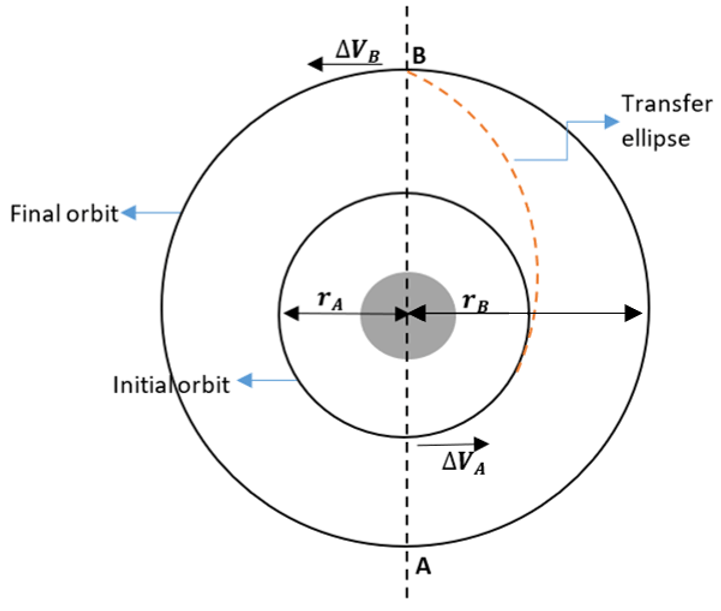This set of Orbital Mechanics Multiple Choice Questions & Answers (MCQs) focuses on “Multi-Impulse Orbital Maneuver”.
1. Multi- impulse maneuver is carried when initial and final orbits do not intersect.
a) True
b) False
View Answer
Explanation: For non- intersecting orbits, single-impulse maneuver is not feasible. This is when multi- impulse maneuver is carries out. For coplanar orbits also it is an efficient means.
2. In which case is the minimum velocity impulse achieved for coplanar maneuver?
a) When impulse is applied tangential
b) When impulse is applied radially
c) When impulse is applied perpendicularly
d) When impulse is applied at 45 deg
View Answer
Explanation: For a coplanar maneuver, multi-impulse maneuver is very efficient. The minimum velocity impulse is achieved when the impulse is applied in the same direction of initial and final velocity vector. This is known as tangential impulse.
3. When both initial and final orbits are circular, what is the maneuver known as?
a) Bi- elliptic transfer
b) Hohmann transfer
c) Phasing maneuver
d) Chase maneuver
View Answer
Explanation: When the initial and final orbits are circular, the optimal maneuver is called a Hohmann transfer. This transfer consists of two tangential velocity impulses which I applied at the initial and final radius.
4. Where does the smallest possible transfer ellipse occur for a Hohmann transfer?
a) Only perigee of the final orbit
b) Only apogee of the final orbit
c) Perigee and apogee of the final orbit
d) Equator
View Answer
Explanation: When there is a Hohmann transfer, the smallest possible transfer ellipse occurs when the transfer takes place at either apogee of perigee of the final orbit which is at a point opposite to the terminating point.
5. What is the time required for a Hohmann transfer?
a) Half of the transfer ellipse period
b) One- third the transfer ellipse period
c) Twice the transfer ellipse period
d) Four times the transfer ellipse period
View Answer
Explanation: The time period of the Hohmann transfer is half of the period of transfer ellipse.
The formula to compute the Hohmann transfer is given by:
tH = π\(\sqrt{\frac{a^3}{\mu}}\)
Where, tH is the Hohmann transfer time
a is the semi-major axis.
6. What is the radius of geosynchronous orbit if the earth’s sidereal period is 23 hr. 56 min 4.091 s?
a) 38,451.20 km
b) 40,145.31 km
c) 53,478.17 km
d) 42,164.17 km
View Answer
Explanation: Given, Ts = 23 hrs 56 min 4.091 s = 86,164.091 s
The radius of geosynchronous orbit is calculated using sidereal time by the formula:
rf = \(\Big(\frac{T_s \sqrt{\mu}}{2\pi}\Big)^{2/3} = \Big(\frac{86,164.091\sqrt{398,600}}{2\pi}\Big)^{2/3}\) = 42,164.17 km.
7. Which of these is not a multi-impulse transfer?
a) Hohmann transfer
b) Bi-elliptic transfer
c) Single-impulse maneuver
d) Phasing maneuver
View Answer
Explanation: Hohmann, Bi-elliptic and Phasing maneuver involve multiple impulses to achieve the final orbit. Meanwhile single impulse maneuver makes use of one impulse to adjust perigee and apogee height, rotate line of apsides and change plane.
8. How many velocity increments are required to carry out the Hohmann transfer?
a) 1
b) 2
c) 3
d) 4
View Answer
Explanation: Two velocity increments in total are required to carry out Hohmann transfer. The first velocity increment is done at the inner circular orbit in the direction of the spacecraft. This places it in a higher energy elliptical trajectory. Once reaching the perigee of the elliptical orbit, the second velocity increment is carries out using thrusters to place it in the outer circular orbit.

9. For which of these cases, the transfer orbit intersects the final orbit at an angle?
a) Hohmann transfer
b) Bi-elliptical transfer
c) One-tangent transfer
d) Chase maneuver
View Answer
Explanation: To transfer a satellite between orbits in less time but with more energy than that is required to complete by the Hohmann transfer, one- tangent burn transfer orbit is used. Transfer orbit is tangential to the initial orbit. It intersects the final orbit at an angle thus, infinite number of transfer orbits are possible.
10. How many burns are required to successfully carry out Bi-Elliptical Hohmann transfer?
a) 1
b) 2
c) 3
d) 4
View Answer
Explanation: In order to carry out Bi-Elliptical Hohmann tranfer 3 burns are required. 1st burn is to convert the circular orbit at r1 to elliptical orbit with perigee rp = r1 and apogee ra = r*. The second burn is carried out at the apogee to raise the perigee of elliptical orbit to r2. Finally at perigee, the orbit is circulized by lowering the perigee to r2.
Sanfoundry Global Education & Learning Series – Orbital Mechanics.
To practice all areas of Orbital Mechanics, here is complete set of 1000+ Multiple Choice Questions and Answers.
If you find a mistake in question / option / answer, kindly take a screenshot and email to [email protected]
